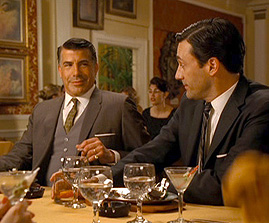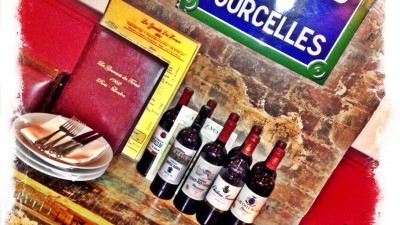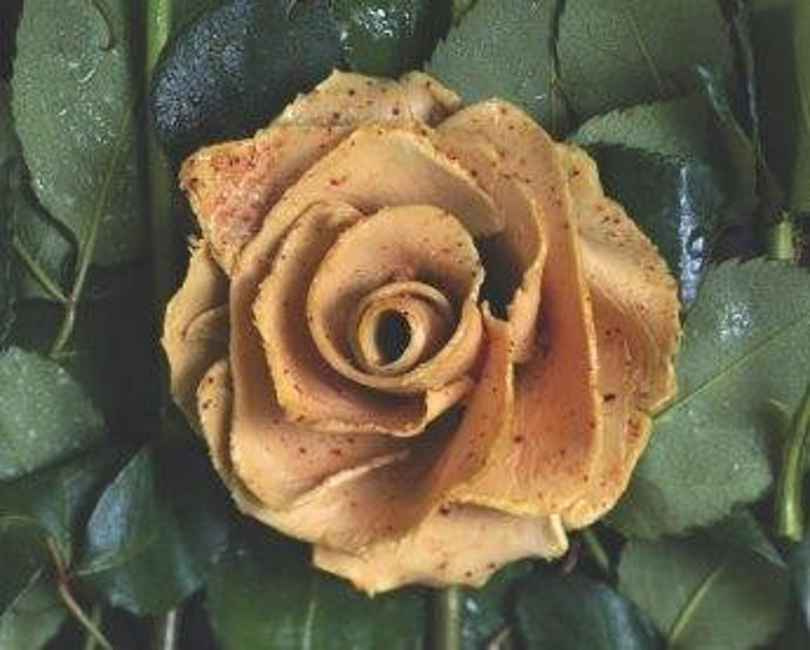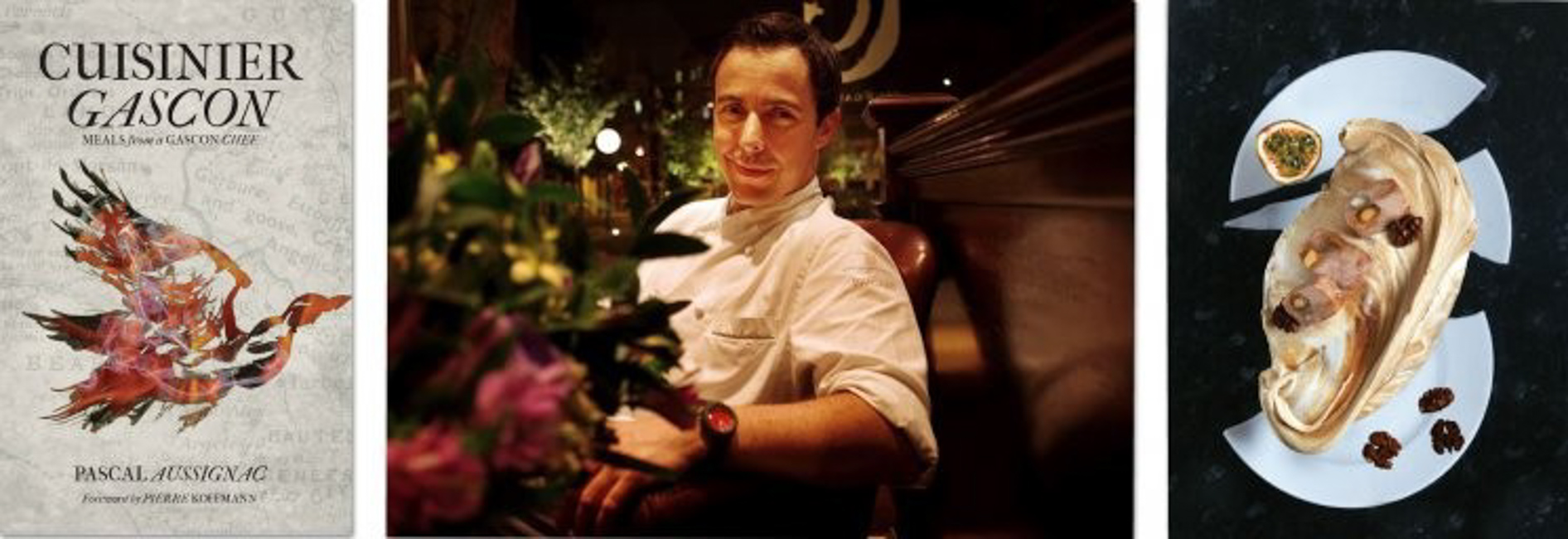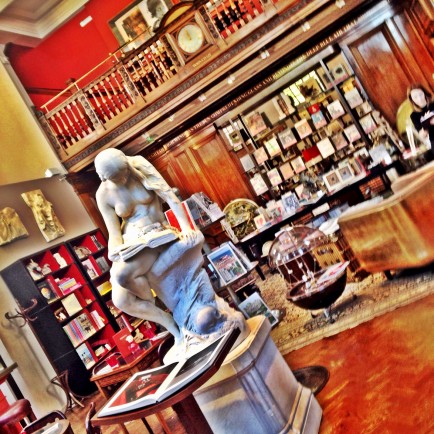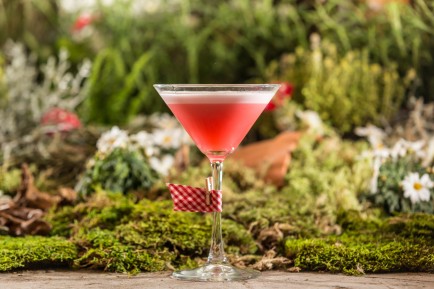Originally from Toulouse and having trained under Guy Savoy, Pascal Aussignac (41) opened Le Club Gascon near Smithfield market in East London in 1998, in partnership with Vincent Labeyrie, himself a descendent of a well-known foie gras distribution company. Strengthened by the success of the restaurant, featuring speciality dishes from South-West France and holder of a Michelin star since 2002, they have since opened several bars and restaurants. Here, the chef gives Chic-Londres the lowdown on foie gras and offers an original take on this delicacy served as pudding from his recipe book Cuisinier Gascon.
Carpaccio of foie gras (Photo: Jean Cazals, Cuisinier Gascon)Foie gras: a brief history
“Foie gras is one of the culinary treasures of France’s south-west and has always has been considered a luxury, its consumption usually associated with celebrations. For instance, because of its one-time seasonality, it used to be bought in the greatest quantity at Christmas time.
Until quite recently, it was eaten in France at the end of a meal, presumably when the sweeter wines were served. Nowadays it has become an introduction to a meal, but still with a sweet white wine such as Sauternes. I also like to serve it marinated in a particular spirit, with a shot glass of that same spirit. Otherwise, a good Champagne or port would be ideal accompaniments.
Foie gras translates literally as “fat liver”, which entails fattening or over-feeding the bird -goose or duck-, in a process known in French as “gavage”. This process is not new: paintings in the tombs of some Ancient Egyptians show farmers holding geese by the throat feeding them with balls of grain and it is thought they served the fattened creamy livers sweetened.
There are many apparent references in Greek and Roman literature to fattened livers served at sumptuous banquets, with the geese previously fed a diet of figs. It was a technique applied to other animals too, fattening them before slaughter, so it is possible that the Romans introduced the technique to the local Basque tribes in their province of Aquitania and the tradition continued for centuries in France. This technique received a boost in the17th century, when maize arrived from the New World via Spain, as foie gras ducks and geese have been fed on maize ever since.
France is the world’s primary producer of foie gras, the majority coming from Gascony, Les Landes and the Dordogne, where duck is the prime bird used. The other major foie gras area of France, Alsace, tends to specialise more in goose. Foie gras used to be a seasonal product: as geese do not breed more than once a year, birds born in the spring and fattened in the autumn would be ready in early winter, coinciding with Christmas demand. Duck are more prolific breeders, and can be bred for meat all year round and a by product of the “gavage “are plump duck breasts, or “magrets”.
Some advice on cooking foie gras
I serve foie gras in many ways in my restaurants: salted, smoked, sautéed baked and steamed, or raw and chilled, like a carpaccio. The simplest way of cooking a lobe of foie gras is by sautéing. It is important to season the liver well (I personally use what I call my “crazy salt”, a mixture of fleur de sel and Espelette pepper) and I also often marinate foie gras before cooking it. Armagnac is traditionally used in Gascony, but Sauternes (or the cheaper Monbazillac or sweet Jurançon) are also well known. Over the years I have explored other marinade alcohols such as sangria, saké, ouzo or Baileys.
You have to preheat a good non-stick pan (no oil). When the pan is hot and starts smoking, add the foie gras: do not crowd the pan. Sear for about 40 seconds, then turn over and cook for a further 40 or so seconds (depending on size). The pieces should have browned nicely. Remove from the pan, and if cooking other pieces, get rid of any burned fat.
Foie gras is also quite delicious cooked lightly on a barbecue over smouldering pine branches or needles. Place it straight on top of a griddle with smouldering pine branches underneath to just sear the outside, about 2 minutes, then remove or cook it wrapped in foil to retain the delicious cooking juices. You’ll have a beautifully aromatic foie gras with pine flavoured fat to die for.”
Recipe: Turrón Foie Gras
“The Egyptians are said to have eaten foie gras as a pudding, and surprisingly enough, foie gras can still be served as a dessert, a recipe often on offer in Club Gascon. The idea is quite a challenge for many customers but the tastes are amazing.”
Ingredients (serve 4-6)
- 350g fresh duck foie gras
- 3 tablespoons Bailey’s Irish Cream
- 2 teaspoons caster sugar
- 65g turrón nougat, cut in small cubes
- 50g fresh walnut halves
- 6 passion fruits
- 1 tablespoon lemon juice
- 10g cocoa powder
- Some small crisp meringues, to serve
Preparation
- Preheat the oven to around 75°C/Gas ¼.
- Re-shape the foie gras in a mould (like a small loaf tin), pressing in the cubes of nougat and walnut halves, like a chess board. Cover the top with cling film and weigh lightly down as you chill the mould until firm.
- Meanwhile, make the passion fruit sauce. Halve and scoop out the flesh and seeds from all the fruits. Put two-thirds of this in a small saucepan with the lemon juice. Boil for about 2 minutes then strain into a cup through a tea strainer to catch the seeds. Return the juice to the pan and scoop in the remaining fruits.
- Serve with the passion fruit sauce spooned around and pieces of meringue.
Find this recipe and others in Pascal Aussignac’s book: Cuisinier Gascon: Meals from a Gascon Chef, with a Foreword by Pierre Koffmann, Absolute Press (£25)

